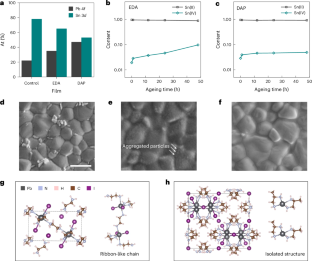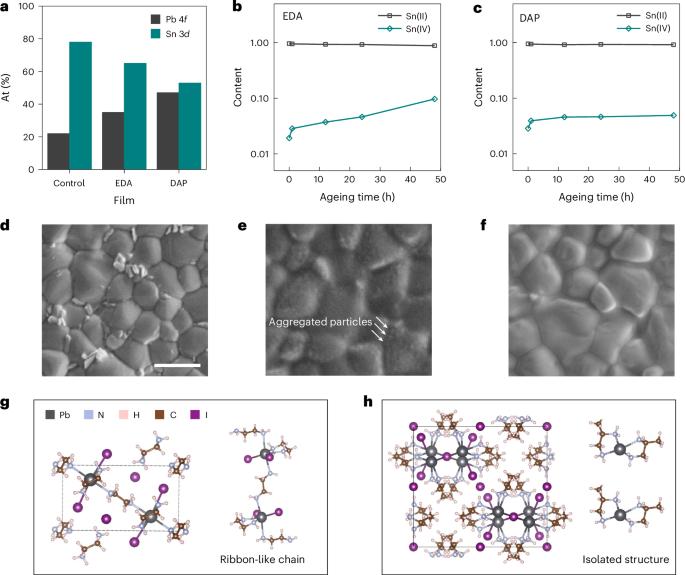Diamine chelates for increased stability in mixed Sn–Pb and all-perovskite tandem solar cells
IF 49.7
1区 材料科学
Q1 ENERGY & FUELS
引用次数: 0
Abstract
Perovskite tandem solar cells show promising performance, but non-radiative recombination and its progressive worsening with time, especially in the mixed Sn–Pb low-bandgap layer, limit performance and stability. Here we find that mixed Sn–Pb perovskite thin films exhibit a compositional gradient, with an excess of Sn on the surface—and we show this gradient exacerbates oxidation and increases the recombination rate. We find that diamines preferentially chelate Sn atoms, removing them from the film surface and achieving a more balanced Sn:Pb stoichiometry, making the surface of the film resistive to the oxidation of Sn. The process forms an electrically resistive low-dimensional barrier layer, passivating defects and reducing interface recombination. Further improving the homogeneity of the barrier layer using 1,2-diaminopropane results in more uniform distribution and passivation. Tandems achieve a power conversion efficiency of 28.8%. Encapsulated tandems retain 90% of initial efficiency following 1,000 h of operating at the maximum power point under simulated one-sun illumination in air without cooling. The stability of perovskite tandem solar cells is an issue. Li et al. show that diamines improve the compositional homogeneity of a low-bandgap perovskite surface and form a low-dimensional barrier that passivates defects, leading to an operational stability of over 1,000 h.


二胺螯合物提高锡铅混合和全长晶串联太阳能电池的稳定性
过氧化物串联太阳能电池显示出良好的性能,但非辐射性重组及其随时间的逐渐恶化,尤其是在锡铅混合低带隙层中,限制了性能和稳定性。在这里,我们发现锡铅混合包晶体薄膜呈现出一种成分梯度,表面的锡过量--我们发现这种梯度加剧了氧化并增加了重组率。我们发现,二胺会优先螯合锡原子,将它们从薄膜表面移除,实现更平衡的锡:铅化学计量,从而使薄膜表面对锡的氧化具有抵抗力。这一过程形成了电阻性低维阻挡层,钝化了缺陷,减少了界面重组。使用 1,2-二氨基丙烷进一步提高阻挡层的均匀性,使其分布和钝化更加均匀。串联系统的功率转换效率达到 28.8%。在空气中模拟单太阳光照、无冷却的情况下,封装串联系统在最大功率点运行 1000 小时后,仍能保持 90% 的初始效率。
本文章由计算机程序翻译,如有差异,请以英文原文为准。
求助全文
约1分钟内获得全文
求助全文
来源期刊

Nature Energy
Energy-Energy Engineering and Power Technology
CiteScore
75.10
自引率
1.10%
发文量
193
期刊介绍:
Nature Energy is a monthly, online-only journal committed to showcasing the most impactful research on energy, covering everything from its generation and distribution to the societal implications of energy technologies and policies.
With a focus on exploring all facets of the ongoing energy discourse, Nature Energy delves into topics such as energy generation, storage, distribution, management, and the societal impacts of energy technologies and policies. Emphasizing studies that push the boundaries of knowledge and contribute to the development of next-generation solutions, the journal serves as a platform for the exchange of ideas among stakeholders at the forefront of the energy sector.
Maintaining the hallmark standards of the Nature brand, Nature Energy boasts a dedicated team of professional editors, a rigorous peer-review process, meticulous copy-editing and production, rapid publication times, and editorial independence.
In addition to original research articles, Nature Energy also publishes a range of content types, including Comments, Perspectives, Reviews, News & Views, Features, and Correspondence, covering a diverse array of disciplines relevant to the field of energy.
 求助内容:
求助内容: 应助结果提醒方式:
应助结果提醒方式:


